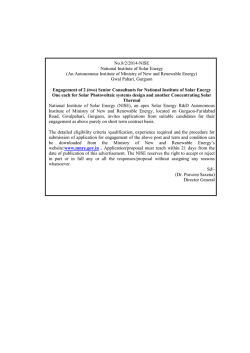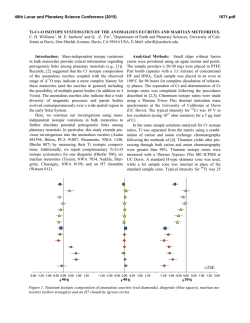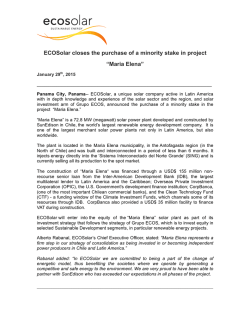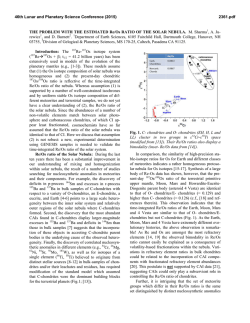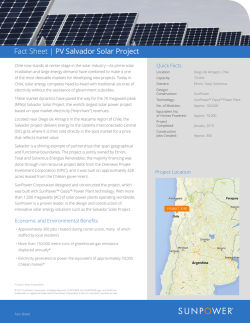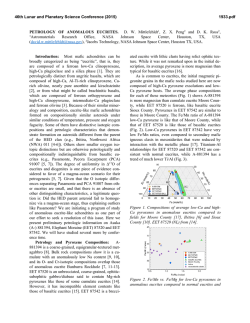
Wet Angrites? A D/H and Pb-Pb Study of Silicates - USRA
46th Lunar and Planetary Science Conference (2015) 1542.pdf Wet Angrites? A D/H and Pb-Pb Study of Silicates and Phosphates. A. R. Sarafian1, S. G. Nielsen1, E. L. Berger2, G. A. Gaetani1, E. H. Hauri3, S. M. Messenger4, K. Righter4, T. J. Lapen5, E. Sarafian1, B. D. Monteleone1, H. R. Marschall1, 1Woods Hole Oceanographic Institution, 266 Woods Hole Rd. Woods Hole MA 02453, 2GeoControl Systems Inc. – Jacobs JETS Contract –NASA JSC, 3Department of Terrestrial Magnetism, Carnegie Institution of Washington, Washington, DC 20015, USA. 4NASA-JSC, Mailcode XI2, 2101 NASA Pkwy, Houston, TX 77058, 5University of Houston, Houston TX, 77204 Introduction: Water plays a fundamental role in planetary processes and is essential for the habitability of planets. Determining when and how the inner solar system received its water is critical in determining how planets evolved. The inner solar system planets are thought to have first accreted dry, then accreted wet material [1]. Abundant work has been done on lunar rocks in an attempt to determine the source, amount, and timing of water accretion to the Moon and inner solar system [2]. Recently, water has been found in eucrite phosphates [3], which crystallized at least by 815 million years after the start of the solar system [4]. Eucrites have an earth-like H, N, and C isotope signature [5], thus probably accreted the same water source as Earth. The discovery of earth-like water in eucrites moves back the time of known water accretion to that of planetesimal formation in the inner solar system. The oldest basaltic meteorites known, angrites, can expand on recent work because they are measurably older than eucrites. Angrites are a small group of differentiated meteorites that can be classified as intrusive and extrusive. They are extremely depleted in volatile metals, but the depletion is not seen in all elements, e.g., noble gasses [6]. Hydrogen, a particularly volatile element, has not been previously measured in angrites, and could help to constrain when and where water originated in the inner solar system. Methods: SEM. We used the Hitachi TM3000 at Woods Hole Oceanographic Institution (WHOI) and the JEOL 7600F at NASA-Johnson Space Center to map all angrites prior to SIMS analysis. We minimized beam exposure to phosphates because the H-isotopes of phosphates can be effected by excessive electron beam exposure [7]. SIMS. We used the Cameca IMS 6f at the Carnegie Institution of Washington to measure H, C, F, Cl, P, and S in olivine and pyroxene. A 15 nA primary beam was rastered over a 15 x 15 µm2 area and the central 10 x 10 µm2 of the secondary beam was collected using a physical field aperture. Measurements of D/H and H concentrations in phosphates were conducted with the Cameca 1280 at WHOI following the procedures of [5]. Briefly, these methods used a 3 nA focused beam that was rastered over a 15 x 15 µm2 area while collecting the central 4 x 4 µm2 after field aperture and electronic gating. LA-ICP-MS. We used a PhotonMachines Analyte 193 wavelength laser ablation system coupled to a Varian 810 quadrupole ICP-MS to analyze U-Th-Pb isotopes in phosphate minerals in D’Orbigny. We used a laser spot diameter of 15 µm and ablated the material for 20 s. Data reduction followed [8]. Common Pb corrections were not applied to these data given that 204 Pb was too low for accurate corrections. Results: We measured water concentrations in olivine in the angrites D’Orbigny and Angra dos Reis, which were found to contain in the range of 20-60 µg/g H2O. In addition, H isotopes in phosphates in Angra dos Reis, and D’Orbigny were measured. All phosphate analyses revealed water (>400 µg/g H2O) that is significantly enriched in deuterium (δD > 500 ‰) compared to the terrestrial value of δD ~ -100 ‰. The measured Pb-Pb age of phosphates in D’Orbigny is 4551 ± 19 Ma (2σ, n = 10), which is within error of its crystallization age of ~4564 Ma crystallization age or just 2-4 million years after crystallization of calcium aluminium rich inclusions [9]. Discussion: Using experimentally derived partition coefficients between olivine and melt of ~0.002 [10], the D’Orbigny melt in equilibrium with olivine contained at least 1 wt% H2O. One must take into account that partition coefficients strongly vary as a function of pressure, temperature, and composition. Thus, our estimate of the water content in an angrite melt should be viewed with caution. However, if this estimate is robust, then angrites are enriched by several orders of magnitude in H2O compared to alkalis and other volatile metals. It has been suggested that H2O does not behave like alkalis and other volatile metals on the Moon [11]. If angrites and lunar rocks are enriched in H2O compared to expected concentrations from a volatile depletion trend, the cause of this behavior is unclear. One possibility for angrites is a heterogeneous accretion of extremely volatile depleted rocky objects and ice-rich material. The H isotope composition of phosphates in angrites is uniformly enriched in D compared to 46th Lunar and Planetary Science Conference (2015) eucrites and the Earth. Four possible mechanisms can cause an enriched D signature: (1) post-crystallization diffusion/alteration, (2) spallation produced D, (3) kinetic isotope fractionation due to magmatic degassing, and (4) the angritic source of the water is enriched in D. (1) The ages of phosphates measured are within error of all other age determinations of D’Orbigny [9]. Therefore, we suggest that it is unlikely that the H-isotopes were significantly altered after crystallization, as Pb and H have similar diffusivities in apatite. (2) The effect of spallation produced D is a function of exposure age and water content. Angrites have young exposure ages (6-19 Ma) [9] while the phosphates measured here have similar water contents to apatites in eucrites. Thus the effect of spallation produced D is < 10 ‰ [5]. (3) Degassing is a viable possibility because kinetic isotope fractionation has a pronounced effect on H isotopes and it has been suggested that angrites may have degassed to some degree [13, 14]. Degassing of a reduced magma has been examined in detail [12] and a significant fraction of H degassing can cause a concomitant increase in fO2. If the angrite magmas degassed ~99%, this could potentially account for the variable fO2 described in angrites [9] and the observed D enrichment in angritic phosphates. (4) Finally, the source of water for angrites could be more enriched in D than that of Earth and eucrites. One possible source of the D enriched H2O could be comets. The possibility of angrites obtaining water from cometary material is difficult to justify dynamically, as angrites crystallized very early in solar system history, requiring comets to have brought water to the inner solar system extremely early. With our limited dataset, it is unclear if the water we measured was affected by post crystallization processes, either by diffusion, impact, or degassing. Thus, it is premature to determine the source of water for the angrite parent body. Possible sources for the angrite parent body remain open to a carbonaceous chondrite-like source, interplanetary dust particle-like source, or a cometary-source. If the source of water for the angrites is carbonaceous chondrite-like, then certain dynamical implications exist. It has been proposed that water-rich asteroids came from just outside the asteroid belt. It is thought that perturbations in the orbits of water-rich asteroids from the influence of Jupiter’s gravity during its “Grand Tack” delivered water to the inner solar system [15 16]. Given that angrites formed extremely early in solar system history it follows that Jupiter would have had to form even earlier. While Jupiter clearly formed very early [17], it is difficult to assess if the accretion of the angrite parent body post-dates Jupiter’s formation. 1542.pdf Additionally, if angrites and eucrites both have a carbonaceous chondrite-like volatile isotope signature, then it is becoming increasingly likely that all of the terrestrial planets accreted with a carbonaceous chondrite-like source, which is in agreement with dynamical models of water delivery to the inner solar system [15]. Conclusions: We build upon the results of [5] and suggest that water accreted to the inner solar system very early. Silicates in angrites are H2O-rich. Phosphates in angrites have significant water and are enriched in deuterium compared to Earth and eucrites. The D-rich water in angritic phosphates could potentially reflect the source of water for the angrite parent body, or it could reflect strong degassing. Relatively recent processes have most likely not reset the H-isotopes because the age of the phosphates agree with previously determined crystallization ages [9]. If Jupiter was the driving force of hydration in the inner solar system, then Jupiter must have formed very early, which may be inconsistent with some estimates of the time scales of Jupiter’s accretion [16] Finally, another mechanism besides Jupiter could have hydrated the inner solar system. References: [1] Schönbächler, M., et al. (2010) Science, 328 p. 884-887. [2] Saal, A.E., et al. (2008) Nature, 454 p. 192-195. [3] Sarafian, A.R., M.F. Roden, and A.E. Patiño Douce, (2013) Meteoritics & Plan. Sci., 2013. 48. p. 2135-2154. [4] Iizuka, T., et al., (2015) EPSL 409 p. 182-192. [5] Sarafian, A.R., et al., (2014) Science, 346 p. 623-626. [6] Baker, J., et al., (2005) Nature, 436 p. 1127-1131. [7] Barnes, J., et al., (2012) Chem. Geol., 337-338 p. 48-55 [8] Shaulis B., et al. (2010) Geochem. Geophys. Geosys,11p.1-12 [9] Keil, K., (2012) Chemie der Erde-Geochemistry, 72 p. 191218. [10] Hauri, E.H., G.A. Gaetani, and T.H. Green, (2006) , 248 p. 715-734. [11] Hauri, E.H., et al., (2015) EPSL, 409: p. 252-264. [12] Sharp, Z.D., F.M. McCubbin, and C.K. Shearer, (2013) EPSL, 380 p. 8897. [13] Righter, (2008) LPSC abs # 1936. [14] Pringle et al., (2014) PNAS 111 p. 17029-17032. [15] Morbidelli, A., et al., (2012) Ann. Rev. EPSL, 40 p. 251-275. [16] Walsh et al., (2011) Nature, 475 p. 206209 [17] Scott, E.R., (2006) Icarus, 185 p. 72-82.
© Copyright 2025
